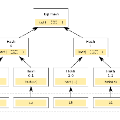In certain blockchain systems, light nodes are clients that download only a small portion of the block. Light nodes are vulnerable to data availability (DA) attacks where a malicious node hides an invalid portion of the block from the light nodes. Recently, a technique based on erasure codes called Coded Merkle Tree (CMT) was proposed by Yu et al. that enables light nodes to detect a DA attack with high probability. The CMT is constructed using LDPC codes for fast decoding but can fail to detect a DA attack if a malicious node hides a small stopping set of the code. To combat this, Yu et al. used well-studied techniques to design random LDPC codes with high minimum stopping set size. Although effective, these codes are not necessarily optimal for this application. In this paper, we demonstrate a more specialized LDPC code design to improve the security against DA attacks. We achieve this goal by providing a deterministic LDPC code construction that focuses on concentrating stopping sets to a small group of variable nodes rather than only eliminating stopping sets. We design these codes by modifying the Progressive Edge Growth algorithm into a technique called the entropy-constrained PEG (EC-PEG) algorithm. This new method demonstrates a higher probability of detecting DA attacks and allows for good codes at short lengths.
翻译:在某些块链系统中, 光节点是只下载区块一小部分的客户。 光节点很容易受到数据可用性( DA) 攻击的伤害, 恶意节点将块块中一个无效部分隐藏在光节点上。 最近, Yu 等人 提出了一种基于去除代码技术的技术, 称为代码Merkle Tree (CMT) 。 由 Yu 等人 提出了一种基于加密代码的技术, 使光节点能够以很高的概率探测DA攻击, 使光节点能够检测DA攻击。 CMT是使用LDPC 代码快速解码的, 但是如果恶意节点隐藏了小节点的代码, 则无法检测DA攻击。 为了打击这一袭击, Yu et al. 使用了经过深思熟虑的技术, 设计了随机的LDPC 代码, 设计了高最低停止设置大小的随机码 。 虽然这些代码不一定适合这一应用。 在本文中, 我们展示了一个更加专业化的LDPC 代码设计,, 以集中的固定的LDPC CDC 模式为重点,, 停止设置。




